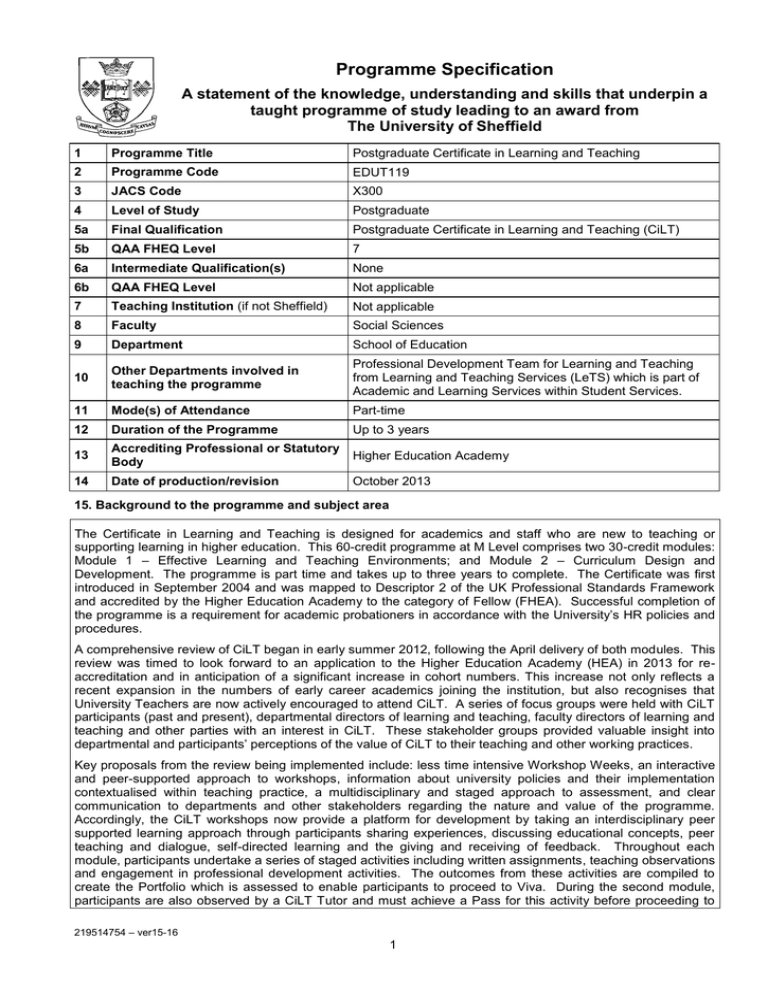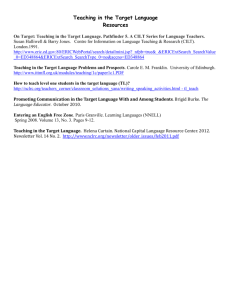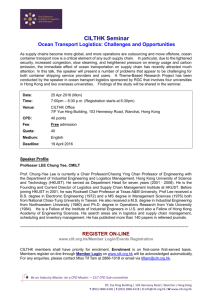1 Programme Title 2
advertisement

Programme Specification A statement of the knowledge, understanding and skills that underpin a taught programme of study leading to an award from The University of Sheffield 1 Programme Title Postgraduate Certificate in Learning and Teaching 2 Programme Code EDUT119 3 JACS Code X300 4 Level of Study Postgraduate 5a Final Qualification Postgraduate Certificate in Learning and Teaching (CiLT) 5b QAA FHEQ Level 7 6a Intermediate Qualification(s) None 6b QAA FHEQ Level Not applicable 7 Teaching Institution (if not Sheffield) Not applicable 8 Faculty Social Sciences 9 Department School of Education 10 Other Departments involved in teaching the programme Professional Development Team for Learning and Teaching from Learning and Teaching Services (LeTS) which is part of Academic and Learning Services within Student Services. 11 Mode(s) of Attendance Part-time 12 Duration of the Programme Up to 3 years 13 Accrediting Professional or Statutory Body Higher Education Academy 14 Date of production/revision October 2013 15. Background to the programme and subject area The Certificate in Learning and Teaching is designed for academics and staff who are new to teaching or supporting learning in higher education. This 60-credit programme at M Level comprises two 30-credit modules: Module 1 – Effective Learning and Teaching Environments; and Module 2 – Curriculum Design and Development. The programme is part time and takes up to three years to complete. The Certificate was first introduced in September 2004 and was mapped to Descriptor 2 of the UK Professional Standards Framework and accredited by the Higher Education Academy to the category of Fellow (FHEA). Successful completion of the programme is a requirement for academic probationers in accordance with the University’s HR policies and procedures. A comprehensive review of CiLT began in early summer 2012, following the April delivery of both modules. This review was timed to look forward to an application to the Higher Education Academy (HEA) in 2013 for reaccreditation and in anticipation of a significant increase in cohort numbers. This increase not only reflects a recent expansion in the numbers of early career academics joining the institution, but also recognises that University Teachers are now actively encouraged to attend CiLT. A series of focus groups were held with CiLT participants (past and present), departmental directors of learning and teaching, faculty directors of learning and teaching and other parties with an interest in CiLT. These stakeholder groups provided valuable insight into departmental and participants’ perceptions of the value of CiLT to their teaching and other working practices. Key proposals from the review being implemented include: less time intensive Workshop Weeks, an interactive and peer-supported approach to workshops, information about university policies and their implementation contextualised within teaching practice, a multidisciplinary and staged approach to assessment, and clear communication to departments and other stakeholders regarding the nature and value of the programme. Accordingly, the CiLT workshops now provide a platform for development by taking an interdisciplinary peer supported learning approach through participants sharing experiences, discussing educational concepts, peer teaching and dialogue, self-directed learning and the giving and receiving of feedback. Throughout each module, participants undertake a series of staged activities including written assignments, teaching observations and engagement in professional development activities. The outcomes from these activities are compiled to create the Portfolio which is assessed to enable participants to proceed to Viva. During the second module, participants are also observed by a CiLT Tutor and must achieve a Pass for this activity before proceeding to 219514754 – ver15-16 1 the final Viva. Although these changes are designed to have a significant positive impact on the learning experiences and professional practices of participants throughout their period of study and beyond, the changes have however, been implemented through a reconfiguration within the overarching delivery modes (workshops and associated activities) and assessment methods (portfolio, teaching observation and Viva) as specified in the original programme documentation; they do not therefore require major changes to the programme specification or associated modules. This Programme Specification and corresponding E1 Forms have therefore been updated in the interests of improving the clarity of the Aims and Intended Learning Outcomes for the Programme and Modules in light of the revised approach and the updated UK Professional Standards Framework. The updated programme has been mapped to the UK Professional Standards Framework and will be presented for reaccreditation at Descriptor 2 as part of the University of Sheffield’s submission to the Higher Education Academy for the (re) accreditation of its learning and teaching development provision. This means that on successful completion of the Programme, CiLT graduates will continue receive a Postgraduate Certificate and be recognised as Fellows of the HEA. The Certificate will continue be a recognised pathway on to the M.Ed. Teaching and Learning for University Lecturers. The programme will continue to be facilitated by tutors from the Professional Development Team for Learning and Teaching in Learning and Teaching Services (LeTS) which is part of Academic and Learning Services (ALS) within Student Services. This team’s activities range from the design, delivery and review of credit bearing programmes, through to short courses and ad hoc advice, covering initial and continuing professional development and informing the development of Learning and Teaching at a strategic level across the University. 16. Programme aims To support and encourage participants to: 1. Become confident, competent and enthusiastic teachers by engaging in peer supported teaching and discussion in an interdisciplinary environment, continuing professional development, scholarship and systematic self-evaluation to develop their teaching practice, support of learning and contribution to programme development throughout their teaching career. 2. Develop a sound interest in, and comprehension of: learning as a process; the factors influencing learners; a range of teaching methods/strategies to create and manage supportive learning experiences and environments appropriately to the given subject matter and academic level. 3. Share teaching practice, experience and expertise with colleagues in their department, faculty and the wider university to foster collegiate support, develop collaborative activities and relationships, consider the impact of collective efforts to support student learning, and engage with wider strategic issues in Higher Education. 17. Programme learning outcomes Knowledge and understanding: K1 Knowledge of learning as a process, factors influencing learners and a range of theories and models of learning and teaching. K2 Knowledge of a range of teaching methods/strategies and their appropriateness to a given subject area and academic level. K3 Knowledge of a range of models and methods of curriculum design, assessment and feedback and their appropriateness to a given subject area and academic level. K4 Knowledge of the wider HE landscape and agenda and its relationship to their own teaching practice, that of their department and the wider university. Skills and other attributes: S1 Identify, evaluate and deploy teaching methods/strategies to design, plan and manage learning experiences appropriate to the given subject and academic level and assess their impact on students’ learning experiences. S2 Identify, evaluate and deploy, teaching theories, models, methods/strategies to create and manage learning environments that engage students in the learning process and support the development of academic and transferable skills. S3 Identify, evaluate and deploy models and methods of curriculum design, assessment, feedback and 219514754 – ver15-16 2 evaluation to the design of learning at the individual session level, and credit/unit level (eg. module or non-credit bearing equivalent) in light of the wider programme. S4 Identify and take account of learner diversity to facilitate equality of learning opportunity for their learners and the given learning community. S5 Systematically analyse and evaluate their performance and experiences as teachers as routine practice to inform and develop their own practices, those of their team and department to support learners and learning. S6 Confidently articulate, discuss and share their knowledge of theories, models and strategic issues associated with learning and teaching in Higher Education in relation to their personal teaching philosophy and practices and those of their team, department and wider University. 18. Teaching, learning and assessment Development of the learning outcomes is promoted through the following teaching and learning methods: The Workshops are designed to introduce participants to models of learning and curricula and to methods of teaching, assessing and evaluating (K1-K4). Workshop tutors model a variety of approaches to teaching and participants are given the opportunity to practice these approaches and to evaluate their appropriateness through interdisciplinary discussion, peer teaching and the giving and receiving of feedback (S1-S7). Engagement in Continuing Professional Development (CPD) activities provides participants with the opportunity to explore and engage in learning and teaching CPD activities within and beyond their department and the University to inform their practice and those of their team and department e.g. attendance at CPD events, structured collegiate conversation (all ILOs but S5 and S6 in particular). Independent study requires participants to examine and pursue their own professional teaching preparation and practices critically, in the light of ideas and insights shared during the workshops, or gained from module reading (all ILOs, but S3 in particular). The online environment is used to provide participants with first-hand experience of working with a virtual learning environment to support the process of learning and teaching and for communication between tutors, participants and peers. Participants will actively engage in online review and feedback e.g. peer assessment for portfolio assignments (outcomes K2 + 3 and S1-S7). Teaching observations provide an opportunity for participants to evaluate the effectiveness of their teaching with the guidance of an experienced teacher and to learn from and be inspired by observing peers and colleagues and providing feedback to them (K1 – K3, S1, S2, S4 and S5). Personal tutorials and Communities of Learning provide an opportunity for participants to plan, discuss and evaluate their learning and teaching practices and development as a teacher with the guidance of a tutor and peers (all outcomes, but S5 and S6 in particular). K1 K2 K3 K4 S1 S2 S3 S4 S5 S6 Workshops Engaging in CPD for Learning and Teaching Independent Study On-line Learning Teaching Observations 219514754 – ver15-16 3 Tutorials & Communities of Learning Opportunities to demonstrate achievement of the learning outcomes are provided through the following assessment methods: The staged portfolio activities provide participants with the opportunity to demonstrate their engagement with the programme aims through capturing and recording their development activities, teaching practices and achievements, personal evaluations, and development of knowledge and understanding, aligned to appropriate learning outcomes. The observation of a participant’s teaching by a CiLT tutor is undertaken to assess the participant’s approach to designing learning experiences in light of session learning outcomes, student diversity and engagement in the learning process. This allows participants to demonstrate their knowledge, understanding and ability to interpret the specified learning outcomes of this programme in the context of their own teaching practice and specific discipline requirements. The post observation self-evaluations and debrief are designed to enable participants to evidence their ability to evaluate their own teaching and how this process informs future practice. Participants cannot proceed to the Module 2 Viva until they have passed this final observation. The Viva enables an in-depth discussion of professional practices and the participant’s development as a teaching professional over the course of the programme and beyond. This allows an examination of the individual’s depth of knowledge and how this has or will be applied to personal, team and departmental learning and teaching practices and the impact of this on the learner and the learner experience. Portfolio Viva Final Teaching Observation K1 K2 K3 K4 S1 S2 S3 S4 S5 S6 19. Reference points The learning outcomes have been developed to reflect the following points of reference: University of Sheffield Strategic Plan QAA Framework for Higher Education Qualifications M.Ed. Teaching and learning for University Lecturers The University Learning, Teaching and Assessment Strategy http://www.shef.ac.uk/lets/strategy/lts School of Education’s Learning and Teaching Strategy The University’s plan for the future http://www.shef.ac.uk/strategicplan/mvi Feedback from our external examiner Dilly Fung: http://www.sheffield.ac.uk/polopoly_fs/1.308340!/file/ExExRep2013.pdf UK Professional Standards Framework and associated HEA accreditation requirements: http://www.heacademy.ac.uk/ukpsf 20. Programme structure and regulations The Certificate programme comprises two core 30 credit modules: Module 1 – Effective Learning and Teaching Environments; and Module 2 – Curriculum Design and Development. Successful completion of this programme is a probationary requirement for new lecturers as stipulated by institutional policy (Human Resources). 219514754 – ver15-16 4 The programme is structured to provide participants with a pathway to the M.Ed. Teaching and Learning for University Lecturers. Detailed information about the structure of programmes, regulations concerning assessment and progression and descriptions of individual modules are published in the University Calendar available on-line at http://www.shef.ac.uk/govern/calendar/regs.html. 21. Student development over the course of study The creation of the portfolio is particularly important as an evolving record of participants’ increasing experience, knowledge and understanding of education as they progress through the programme. At the start of the programme, many participants have expert knowledge in their subject disciplines, but have less experience of teaching in higher education. The first module is designed to support participants to explore and develop their current conceptions of learning and teaching and to invite them to widen and deepen those conceptions, to embrace notions of active and student-centred learning and research-led teaching through an interdisciplinary peer supported learning approach. At the end of the first module, participants should be able to draw on an understanding of models of learning and a range of teaching techniques, to facilitate learning to meet the needs of a diverse group of learners. They should be able to demonstrate in their portfolio and in the Viva that they are gaining increased competence and confidence as practising teachers, with a broad understanding of the settings and contexts in which students learn in general and in their particular discipline. The second module is intended to introduce participants to good practice in course design and, in particular, to the roles that assessment and evaluation play in learning and the curriculum. This module focusses on conceptual frameworks of curriculum design and provides an interdisciplinary forum in which to design and critically evaluate learning and assessment activities. This module also requires participants to engage with strategic/policy issues associated with learning and teaching in the wider HE context and consider the role and impact these have on their own practice and those of their department and wider University. Participants should be able to demonstrate, in their portfolio and in the Viva, that they are able to apply models of curriculum design and that they can defend their design decisions in a scholarly manner. They should also be able to demonstrate their awareness of strategic/policy issues associated with learning and teaching in HE and their impact on their practice and those of their department and the University. Throughout both modules, participants experience the use of learning technologies via the on-line learning environment, providing opportunities to explore and evaluate the potential impact and appropriateness of its use in their own practice. 22. Criteria for admission to the programme To take part in the programme, applicants should normally hold a degree level qualification or equivalent in their discipline or subject/area of expertise. They must also have teaching commitments or be involved in the support of learning at the University of Sheffield. 23. Additional information This specification represents a concise statement about the main features of the programme and should be considered alongside other sources of information provided by the teaching department(s) and the University. In addition to programme specific information, further information about studying at The University of Sheffield can be accessed via our Student Services web site at http://www.shef.ac.uk/ssid. 219514754 – ver15-16 5

